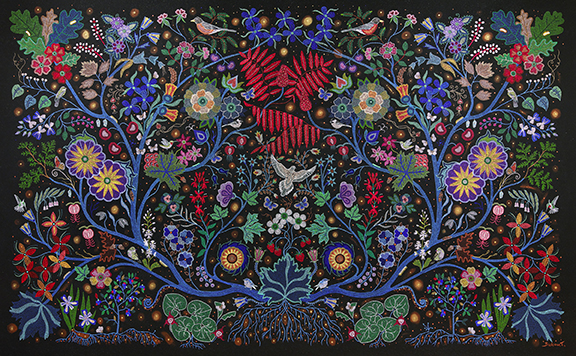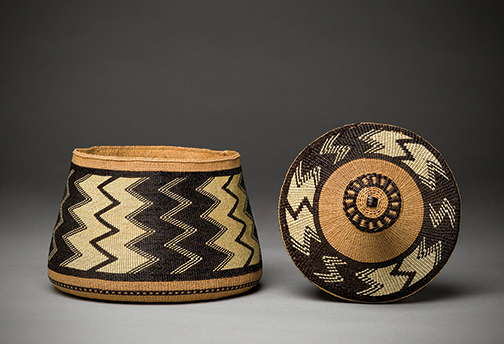By Marianne Combs/MPR
Walking up to the main exhibition hall on the Minneapolis Institute of Art’s second floor, you might think you’ve come to the wrong place. This is supposed to be Hearts of Our People, the first major exhibition dedicated to the artwork of Native American women, and the first thing you see is a car.
Dominating the entrance is a gleaming black 1985 Chevy El Camino. The elaborate custom detailing is the work of artist Rose Simpson.
“Rose made this vehicle from top to bottom,” said Teri Greeves, co-curator of Hearts of Our People. “She painted it. The upholstery work and the inside, all that leather work is her work, and all the accessories that are on it are all her.”

Tricked out with sleek contrasting glossy and matte designs, the low-rider is a bold homage to Pueblo blackware pottery and Santa Clara Pueblo culture. Greeves said the car is a commentary on the strength of indigenous women, and how – despite colonization, re-education and displacement – they have kept their communities alive and running.
Greeves is a beadworker and enrolled Kiowa. She said this exhibition is more than just a collection of beautiful objects – it’s an honoring of Native American women.
“These women have done amazing things,” Greeves said. “They really are our culture bearers. They are our mothers, they are teachers. They are the frontlines of our life.”
Hearts of Our People includes everything from pottery, beadwork and textiles to photography, abstract painting and film. More than 50 communities and cultures from all over North America are represented. Many of the artwork descriptions are written in English and in the original languages of the artists. Small baskets are placed throughout the exhibition for Native people to make offerings. Video screens allow visitors to hear directly from the artists.

Jill Ahlberg Yohe, associate curator of Native American art, said the show has been five years in the making. She and Greeves worked with an advisory board of more than 20 Native women artists and scholars from Native and non-Native backgrounds.
“Teri and I knew that we did not have the expertise or the authority to be talking about all of this material and we knew people who did,” Yohe said. “And that is supremely important to recognize, the fact that no one sole or two curators can tell a story of this magnitude. Yes, it takes a long time. Yes, it’s harder. But it is worth it. It’s the right way to do it.”
Greeves said the exhibition is divided into three themes — legacy, power and relationships.
“In the Western world, relationships oftentimes can be simplified into human-to-human relationships,” she explained. “But in the Native world it’s beyond that. It is actually a relationship that you have as a maker with the things, with the materials, that you’re using … . So the buffalo robe that we’re sitting in front of is actually a brother. That’s a relation.”

The robe Greeves pointed to was harvested in 1882, at the last great buffalo hunt. On the facing wall is a photograph taken in 2016 of military veterans marching in support of the protesters at Standing Rock. Both events happened on the same land, more than 130 years apart. Both speak to colonialism and its effects on natural resources.
Greeves said she hopes people who see the show will come away with a deeper understanding of the profound role Native women play in their communities.
“Community members don’t need an exhibition at the Minneapolis Institute of Art to understand the importance of the women,” she said, “but to let the rest of America get an idea of what we know in our home communities of all of the things that women bring to our world.”
Hearts of Our People runs through Aug. 18 at the Minneapolis Institute of Art. Admission is free for Native people. It then travels to Nashville, Washington D.C., and Tulsa, Okla.
Minnesota Public Radio News can be heard on MPR’s statewide radio network or online.








